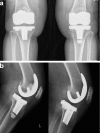Cementless and cemented total knee arthroplasty in patients younger than fifty five years. Which is better?
- PMID: 24420155
- PMCID: PMC3923946
- DOI: 10.1007/s00264-013-2243-4
Cementless and cemented total knee arthroplasty in patients younger than fifty five years. Which is better?
Abstract
Purpose: The purpose of this prospective, randomised study was to evaluate long-term clinical results, radiographic findings, complications and revision and survivorship rates in patients <55 years at a minimum of 16 years after undergoing bilateral, sequential, simultaneous, cemented and cementless total knee arthroplasties (TKAs) in the same patients.
Methods: Bilateral, sequential, simultaneous TKAs were performed in 80 patients (160 knees). There were 63 women and 17 men with a mean age of 54.3 years (range 49-55), who received a cementless prosthesis in one knee and a cemented prosthesis in the other. The mean follow-up was 16.6 years (range 16-17).
Results: At final review, the mean Knee Society (KS) knee scores (95.8 versus 96.9), Western Ontario and McMaster Universities (WOMAC) osteoarthritis (OA) index (25.4 versus 25.9), range of motion (ROM) (125° versus 128°), patient satisfaction (8.1 versus 8.3) and radiological results were similar in both groups. Femoral component survival rate was 100% in both groups at 17 years; at 17 years, the cemented tibial component survival rate was 100% and the cementless tibial component 98.7%. No osteolysis was identified in either group.
Conclusion: Long-term results of both cementless and cemented TKAs were encouraging in patients with OA who were <55 years. However, we found no evidence to prove the superiority of cementless over cemented TKAs.
Figures


References
-
- Scuderi GR, Insall JN. Total knee arthroplasty: current clinical perspective. Clin Orthop Relat Res. 1992;276:26–32. - PubMed
-
- Kim Y-H, Kim J-S, Choe J-W, Kim H-J. Long-term comparison of fixed-bearing and mobile-bearing total knee replacements in patients younger than fifty-one years of age with osteoarthritis. J Bone Joint Surg Am. 2012;94(10):866–873. - PubMed
-
- Kim Y-H, Kim J-S, Park J-W, Joo J-H. Comparison of the Low Contact Stress and Press Fit Condylar Rotating-Platform mobile-bearing prostheses in total knee arthroplasty: a prospective randomized study. J Bone Joint Surg Am. 2011;93(11):1001–1007. - PubMed
Publication types
MeSH terms
Substances
LinkOut - more resources
Full Text Sources
Other Literature Sources
Medical

